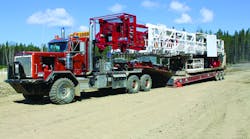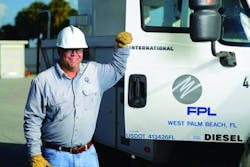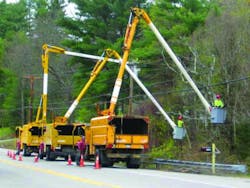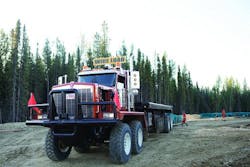Trucks involved in field service often face more bruising and more complicated work than their freight hauling counterparts. Thus, they often require different operational and support strategies compared to trucks slated to haul cargo on local roads and highways.
For starters, trucks deployed in field service usually find their chassis fitted with specific equipment—service bodies, hydraulic booms, even specialized axles and drivetrains—and are often loaded down with tools and supplies as well. They can also frequently find themselves in harsh off-road conditions, forcing their way through dirt and mud to complete their tasks.
It’s often not the miles that put wear and tear on field service fleets; it’s the hours spent powering boom arms or fracking equipment, exposure to all sorts of weather conditions, and functioning more like mobile generators than trucks.
To provide some insight into just some of the many different needs of field service trucks, Fleet Owner profiled three specific types of fleets: an electric utility company, a tree service firm, and a hard-working oil field business.
The trucks involved in each case study differ vastly from one another, if not in design, then in purpose. An electric utility truck may sport specifications similar to that of one fitted for tree-trimming work, but the type of work conducted on a daily basis is far different, as are the needs of their respective customer bases.
In each case, these trucks are designed to provide the most efficient operation possible and are guided in likewise manner by field service strategies that deploy telematics, hybridization, and even specific frame rail specifications to attain maximum efficiency. It’s that efficiency that translates into savings for those fleet operators at the end of every tough workday.
Case Study No. 1: Providing power from the catbird seat
By Wendy Leavitt
On Aug. 3 of this year, the U.S. Environmental Protection Agency (EPA) issued proposed regulations designed to sharply curb emissions from electrical powerplants, sending shock waves through many utilities around the country—especially those operating coal-fired power plants. For Florida Power & Light Co. (FPL), a subsidiary of NextEra Energy Inc., however, switching to cleaner technologies for its power generation facilities as well as for its vehicles has long been business as usual.
Today, the huge utility, the third largest electric utility in the U.S., is using natural gas along with nuclear and solar power to produce electricity. It also has a strategy in place to phase out its remaining older power generation facilities. In 2014, for instance, FPL retired two of its gas- and oil-fueled generating plants, one in Putnam County and another in Miami-Dade County. Two long-term agreements to purchase power from older natural gas- and coal-fired plants are likewise expected to expire before mid-2019.
There are also plans underway to build additional cleaner, more efficient powerplants using new technologies, including three large-scale solar plants that FPL is building before the end of 2016 and a natural gas-fueled, “high-efficiency energy center” that FPL also hopes to construct and put into operation by 2019. In short, the Florida-based utility is in an enviable position today—a solid green catbird seat of a spot.
“Because we have lived and breathed our affordable clean energy commitment for many years now, Florida Power & Light is one of the cleanest electric generating companies in the U.S. Although we have not yet reviewed the final version of the rule, we support the overall objective of achieving meaningful emissions reductions and encouraging investment in a clean energy future,” the company says. “Unlike many electric utilities across the country, FPL is well-positioned to meet the goals of the Clean Power Plan— with no expected additional costs. Clean, high-efficiency natural gas energy centers, along with cost-effective energy efficiency programs and zero-emissions nuclear and solar power, ensure FPL can continue to reliably deliver affordable clean energy for customers 24 hours a day, 365 days a year, now and in the future.”
FPL’s fleet operations are as green as its power generation facilities. According to the company, in 2006, FPL became the first utility in the nation to place in service a medium-duty, hybrid-electric bucket truck. Today, the utility operates one of the largest green fleets in the country with approximately 1,750 biodiesel-powered vehicles (FPL is the largest user of biodiesel in Florida) and 560 electric and hybrid-electric vehicles. Its clean-vehicle fleet saved 665,000 gals. of petroleum fuel and prevented more than 6,400 tons of carbon dioxide emissions in 2014 alone, FPL reports.
“Our green fleet lowers operating costs for the company, savings we can pass on to our customers.
This is one reason why our bills are the lowest in the state and 30% lower than the national average,” says Joe Suarez, director of FPL’s fleet services. “We have a robust electric vehicles program designed to help educate and engage our customers on the benefits of electric vehicles (EVs). Each year, we participate in community events, outreach sessions, and ride-and-drive opportunities to raise the public’s awareness about EVs. Our goal is to provide customers with information about different plug-in electric vehicle models available, the cost to operate them, and how to safely charge them.”
The company notes that it is also “committed to converting our entire fleet of company cars and trucks to plug-in electric or hybrid-electric over time.” FPL already has electric vehicle charging stations at its newest plants and a parking canopy with solar panels that uses sunlight to help recharge electric vehicles at its headquarters.
In 2014, FPL received the EPA’s Clean Air Excellence Award, which honors innovative programs that benefit communities, the environment, and the economy.
Case Study No. 2: Telematics boosts operational efficiency
By Cristina Commendatore
When it comes to successfully managing its fleet, maintaining equipment, and just getting the job done, Lucas Tree Experts relies on telematics software.
The tree, vegetation management, and storm restoration services provider first started using Telogis software back in 2005. Since then, the company has been able to shrink the size of its fleet, which serves utility and commercial customers across New England, the southeastern U.S., and Canada, while maintaining its efficiency, co-owner and CFO Art Batson III told Fleet Owner.
Batson explains that many companies often focus on their fleet’s depreciation schedule and inevitably collect older equipment over the years. Lucas has another approach.
“We look at it differently,” he says. “We’re really measuring the uptime and downtime of that equipment. When we’re idling, there are certain costs that will incur. Telogis gives us actual information on that equipment. It has helped us shrink our fleet, but we’re using our fleet more efficiently, which has helped lower costs.”
Telogis also helps Lucas leverage two-way communication between vehicles and management, with liability problems during accident investigations, and to ensure workers are driving safely and efficiently. Batson also notes that through telematics, truck engines emit alert codes so management can notify foremen in the field when a vehicle needs to be repaired.
Much of Lucas’ s work comes from utility companies and getting called in to restore services during and after major storms. Telogis improved the process for expediting restoration efforts after a storm, Batson says.
“When we have a big storm, we will give our existing customers access to the Telogis portal so they can log in and see where our equipment is,” he says. “Instead of trucks always having to come back to get handwritten orders or come back to a staging area, they can communicate via text message where emergencies are, where the closest truck is, and then move them there.”
The Lucas fleet comprises 400 vehicles and nearly 500 trailers and other pieces of equipment attached to the trucks. Batson says the company predominantly uses Ford for its light-duty trucks and International for heavy-duty operations. He added that the company has used International for the past six or seven years because of its emissions control solutions, but he expects to expand and incorporate Freightliner models as well.
The company was founded in 1926 in Portland, ME, by John Lucas. With only a truck, ladder, climbing ropes, and a hand saw, Lucas provided line clearance services for the expansion of electricity and telephone services in rural Maine. When Lucas died in 1931, W.H. Hinman purchased the company and ventured into transmission line and underground conduit construction and right-of-way clearing for oil and gas pipelines.
In the late ’50s, aerial bucket trucks and brush chippers were introduced, and in the 1980s, the Batson family, which has managed the company since the ’60s, purchased Lucas from the Hinman family.
Nearly 90 years after its founding, the fleet now consists of hybrid-electric bucket trucks, off-road trucks, chippers, aerial lifts, trimmers and side buckets. Batson mentioned that all of the company’s chippers include telematics software.
Since the company’s drivers are always on the move, trucks don’t park at one particular garage or facility. So telematics helps keep the fleet centralized, Batson says.
And what makes Lucas really stand out from other fleets is that its drivers not only carry their commercial driver’s licenses, but they’re certified arborists, too.
“Twenty years ago, our guys wouldn’t [think of] themselves as driving commercial trucks; they were arborists,” Batson explains. “Now they consider themselves arborists who drive commercial trucks.”
Fleet No. 3: Rough and ready for the oil patch
By Sean Kilcarr
Oil is often referred to as black gold, for it’s a precious commodity that fuels the world’s transportation needs and, in turn, the global economy. According to the Energy Information Administration, about 74% of the 6.89 billion barrels of petroleum used in the U.S. in 2013 went into making gasoline, heating oil/diesel fuel, and jet fuel—all prime drivers of the nation’s transportation network.
Trapped in the porous geologic foundations under the earth, getting at that black gold is not an easy task because of the often remote locations where drilling crews must set up. That’s why tough truck specifications are vital in oil patch work.
Founded in 2010, ATK Oilfield Transportation provides oil rig moving services throughout Western Canada and Texas, relying on a fleet of 65 Kenworth “tandem-tandem” model C500 trucks to move heavy loads into and out of remote locations.
“Most critical to our business are our large tandem-tandem C500s,” ATK’s COO Les Ovelson says. “With a 430-in. wheelbase and a large longbed used to physically dismantle drilling rigs, the C500 is the most significant piece of equipment we have.”
He explained that ATK specs its C500s with “all the heavy-duty bells and whistles” it can. Its largest C500 flatbeds are equipped with tandem steer and tandem drive axles, powered by Cummins ISX15 600-hp. engines.
The trucks also feature Allison automatic transmissions and four-speed auxiliaries, Dana-brand 22,000-lb. steer axles and 90,000-lb. Kessler rear axles.
Yet Ovelson stresses that one of the biggest spec’ing advantages to ATK’s Kenworth C500s is the straight frame rail that runs to the very front of the truck.
“When we get stuck in the mud with 230,000 lbs. of gross weight, we’re able to tie a couple of trucks together to pull,” he explains. “That strong foundation is vital in the oil fields.”
That foundation is crucial during oil rig setup operations, too, when the company’s “pole-up” tandem-tandem trucks go to work. Each of those trucks features a 60-ton main winch and a 11/4-in. line with a secondary 40-ton winch and 7/8-in. line.
ATK also developed a hydraulic line tensioner to deal with ever-larger oil field drilling rigs. Larger rigs require rig moving trucks to have longer wheelbases and taller deck heights, making it more difficult to handle winch lines. The line tensioner keeps those winch lines neatly spooled, greatly reducing the need for workers to handle the lines by hand.
ATK also develops special vehicle components on its own to further improve fleet operating efficiency. One is the “SubLauncher,” designed to make it easier to remove the substructures from tall rigs without using pole trucks. The device attaches to the deck of ATK’s trucks and increases overall live-roll height. This eliminates the need to use ramps to remove rigs, provides greater round clearance, and reduces oil rig tearout and set times for customers.
Ovelson notes that even the paved roads traversed by its highway-focused tractors can take a toll on equipment, especially when pulling heavy loads.
“Our C500 winch tractors pick up the heavy loads and, for the most part, travel up and down the highway taking rigs from point A to point B,” he explains.
By contrast, ATK’s heavy tandem-tandem bed trucks work on location with their winches to physically assemble and dismantle drilling rigs. “They put on a lot less miles than our hauling trucks, so their service life is a lot longer,” he explains.
That long service life is important, because those tandem-tandem C500s cost $850,000 to $1 million a pop. ATK keeps them for 10 years before rebuilding them, in contrast with the C500s slated for primarily highway operation that get traded out after five years.







